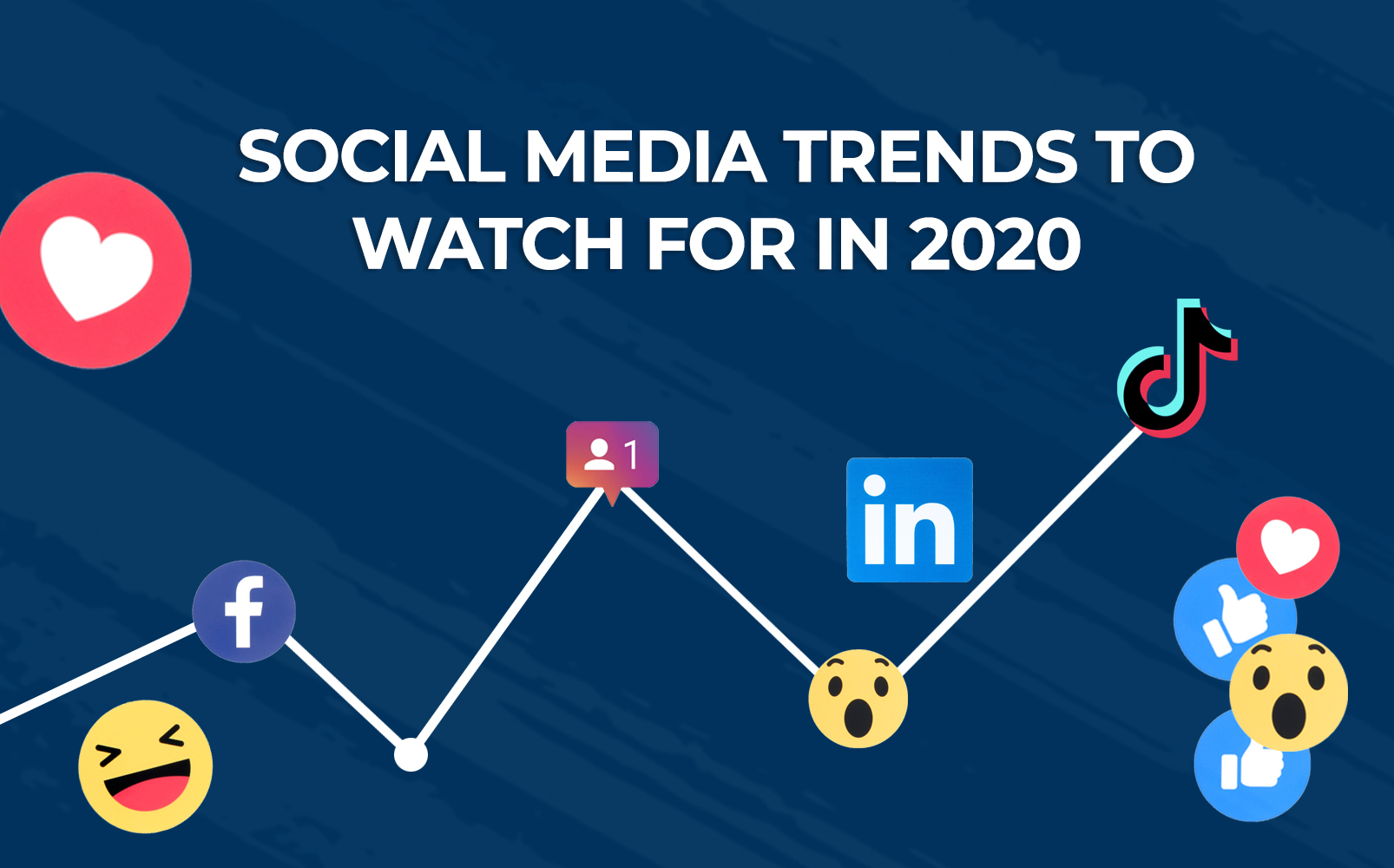Social media is always changing and it's the marketer’s job to adapt and thrive. Here are some tips and tricks to help you take advantage of the top social media channels and what you should be doing to stay on top of trends in 2020.
The Platforms to Watch
Juggling all the social media platforms gets more complicated every year with new ones rising up, the stalwart old guard standing pat, and a few riding out into the sunset. Social media moves fast and if you’re stuck focusing on one thing you may not even notice the new ones that spring up or that what you’re using is dead.
This year alone, platforms like Tik Tok and Instagram have made huge leaps in users while Facebook, Twitter, and LinkedIn have continued steady growth and remained at the top of the crop.
To nobody’s surprise, Facebook is a beast. 70% of US adults say they use Facebook and the numbers are strong for every age range, too. Marketing on Facebook is a fact of life at this point. If you’re not using it, you might as well start because there’s no social platform better at reaching specific audiences and growing a brand page.
Something for 2020: if you haven’t used Facebook Live yet, it might be time to start. Users watch 3x as much live video as they do pre-recorded ones and live streams are a great way to boost engagement if you find your posts struggling to find grip.
Tik Tok
In many ways the successor to Vine, Tik Tok is a platform for making short videos. Tik Tok was founded in 2017 but 2019 was the liftoff year for the platform, growing to over 500 million worldwide users.
Marketing on Tik Tok effectively really depends on the business. Tik Tok’s user base is very young with 41% of users between 16-24. It’s not for everyone and creating engaging content that gains traction is not easy. People on social media are more wary than ever about seeing ads and 27% of people even view then negatively. This only strengthens the importance of Brand Affinity Marketing and creating great content that brings people to your website rather than bombarding their timelines with ads.
LinkedIn has made big strides lately and added lots of new features to make posts more interesting. You can now publish blogs and other written content to your page and host live videos. And, with the rise of micro-blogging (as we’ll discuss below), LinkedIn’s format is perfect for a short piece of written content to spark discussion and engagement.
Building your company page is great and can be helpful, but for 2020 you might consider focusing your attention on growing your personal page as an extension of your company brand and using it as a way to start discussions.
The rise of microblogging
Microblogging is the art of using social media posts, which are usually short anyway, as ways to ignite discussion and cover a topic. In fact, most people actually prefer to read posts, blogs, and other content that is less than 1,000 words.
Almost all social media platforms are also good microblogging platforms. In fact, there’s not much difference between standard social posts and microblogs. The only actual difference is putting the content right in the post rather than linking out somewhere else. The goal of a microblog is to inform and discuss on the social platform.

Other benefits are things like:
- Short turnaround: A microblog is something you pop out in a minute. It’s informative and engaging, and most importantly, it’s short.
- Frequency: A shorter post allows you to post more. It’s that simple. You can microblog every day without breaking a sweat.
- Real-time information: Microblogs allow for quick releases of information from brands and people. It can be used as an informal press release to the public and get information moving quickly.
Dark Social
Dark social is not as sinister as it sounds, though it does present a frightening challenge for marketers.
Dark social is all the social media done away from the public light of timelines and walls. Most of the time, it’s in the form of a direct message (DM) on Twitter, Facebook Messenger, WhatsApp, Discord, Slack, and any other platform that allows for direct messages. It’s also becoming very popular, with 63% of people preferring to share things privately or in secluded groups.
So, naturally, a marketer’s first thoughts are: How do I get in there? And, How do I measure it?
Marketing on dark social
The first step is to make content that’s valuable to your audience and easy to share.
Dark social is not a place to sell, it’s a place to build brand affinity and awareness.
People share things like crazy and you want it to be your stuff. Simple, right? That’s what marketing for dark social is, making posts and content that encourage people to share with their friends somewhere dark. It can be anything from memes on social media to a helpful blog shared on your office’s Slack channels. Anything you use to communicate and share on a private network is a channel for dark social.
You can also go the direct route and start messaging people, but that’s thin ice to walk on and one misstep will send you right to the bottom of the lake. This would be a disaster because 71% of people are likely to recommend a company after a positive social interaction. So, the last thing you want on social is for someone to dislike you.
While invading a private space when selling to consumers is dangerous, it’s much more commonplace with B2B marketing and will be much more helpful. A good start is to set up a chatbot right on your site to kickstart the conversation.
If you’re seeing a trend in this blog post, it’s probably the importance of building your brand affinity in 2020. People share more from brands and people that they like and the best way to get people to like you is with great content.
Tracking dark social engagement
Dark social is like dark matter in space, you can see where it should be but it’s just not there. The best way to track dark social sharing is find the holes in your data. Look at direct traffic and filter out anything that leads directly to your homepage; this won’t give you anything exact, but it will give you the number that houses your dark social numbers and give you an idea.
The other route is to use tools like GetSocial’s dark social calculator or other software.
Also, make sure all your links are short and trackable to make them as shareable and trackable as possible.
Influencer Marketing
Influencers are one of the highest forms of brand affinity because they are the brand and their only job is to make content that’s directly aimed at their audience. This has resulted in huge follower counts and an opportunity for marketers.
Influencer marketing has grown right alongside social media as a whole, 80% of marketers say influencer marketing is effective and 71% of marketers say the quality of traffic from influencers is higher than other sources.
It’s an interesting tactic because it has a lot of flexibility, there are influencers for every topic, every budget, and every audience. It really depends on whether you think it’s the right way to get in front of your audience and if you believe the ROI is high enough, though 81% of marketers said the return on investment was comparable to other networks and forms of marketing.
In terms of money, Influence.co published a study on Instagram influencer pricing and found:
- The overall average price was $271 per post.
- The average price for micro-influencers with fewer than 1,000 followers was $83 per post.
- The average price for influencers with more than 100,000 followers was $763 per post.
The biggest tip out there for getting into influencer marketing is to do research, more research, and even more research. The success of using an influencer depends on this success and you finding the influencer that will best reach your audience.
As stated above, there’s an influencer for every little niche you can imagine and there are influencers with huge, varying audiences that can get you in front of many eyeballs. So make sure you do the work and find the one that fits best.
Micro-Influencers
Just finding the most popular influencer in your market or niche may not always be the best option, though. Micro-influencers, influencers with less than 10k followers, are a great way to target very specific audiences with very specific interests. For example, if you wanted to sell snow boots, you might enlist the help of an outdoorsman influencer with a smaller following. Not to mention it will come at a significantly lower cost.
Micro-influencers can also be an effective way to tackle dark social with the help of a paid “Influencer Reach-Out.” It’s less intrusive than a big brand barging their way into your DMs and can even be exciting if one of your favorite influencers sends you a message.
Brand Affinity Marketing and influencers
Using Brand Affinity Marketing, 2020 should be the year you create your own content, become a known entity in your space, and build your own micro-audience much like an influencer would. Whether it be blogs, podcasts, videos, or images, focus on creating exceptional and consistent content that targets your desired audience.
You don’t just need to find and use micro-influencers, you can become one.
The goal of Brand Affinity Marketing is to cut your reliance on other people’s audience, aka renting an audience. Build an audience and own it by having people subscribe so that they’re consistently coming back for more.
Content is king on social media for 2020. With the rise of micro-blogging, micro-audiences, influencers, and video content, there’s never been more competition or opportunity to stand out. The world is always looking for the next great piece of content.
So, in 2020, decide to be that content creator that not only goes viral, but brings people back for more everyday.


.png)

-1-1.png)
